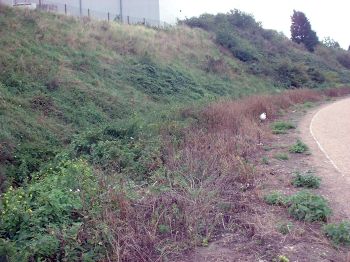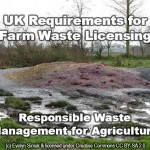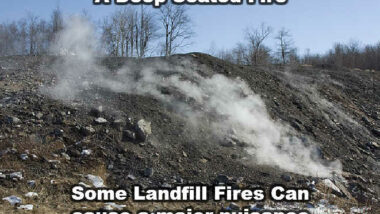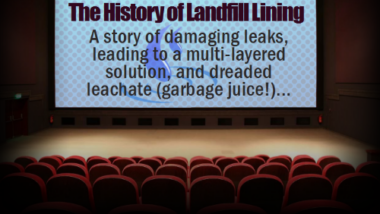
When Does an Old Landfill Cease to be a Landfill?
In other words, when can an old landfill be left as it is, not monitored and used for any purpose it's owner wants to use it for, because it no longer contains anything which harm the environment?
[box size=”large” style=”rounded” border=”full”]There is an easy and glib answer to that question. That answer is: “When it reaches final storage quality”.OK. You say that's fine. But, what exactly does that mean? The fact is that nobody (particularly in the UK) has really done enough research to be able to tell you with any certainty what that means in any worthwhile detail![/box]
In the developed nations formal regulation entailing detailed record keeping for landfills (“dumps”, or “tips” as they then were) has rarely been in place for more than 40 years. Until now these sites where almost without exception clearly not fully decomposed, let alone harmless.
However, the question will arise increasingly from now on as the first properly designed early landfills that were licensed, and where the owners still have to comply with their “licence”, are becoming a lot cleaner are free from landfill gas, and the material in them is at times considered to be reasonably inert and harmless.
These owners would like to be able to hand back their licences and remove the stigma from the land which comes with it being classified as a landfill.
This landfill has been extensively developed with retail park units, and yet leachate is present on this face which exceeds the safe discharge quality.
Due to a lack of reliable data and research on what should be defined as Final Storage Quality, little is known about the real time needed to reach final storage quality for a landfill. In addition, even within the regulatory bodies the concept of final storage quality is poorly understood.
A paper presented at the UK Waste2004 conference by O. Hjelmar and J.B. Hansen of DHI Water and Environment, gives us some guidance in a case a study. They tell us that their results for the site they studied, indicate that even with a relatively high leachate production rate corresponding to a very abnormally high infiltration of 33 % of the precipitation, final storage quality could not be achieved in anything less than 30 years.
Very low concentrations have been reached for some components while others remain of concern.
The other problem is homogeneity. Even if the leachate was shown to be of a quality safe to be discharged to the environment without harm, there would be no guarantee that the whole of the waste had been “wetted” adequately to have completely consistently of that quality. It is possible that man's disturbance of the waste, or geological events which cause disturbance may still cause a polluting leachate due to the lack of homogeneity of all landfills.
In addition, leachate contains so many contaminating substances that creating a full list to encompass all the possible chemicals in leachate would be very onerous. This no doubt explains why so few, apart from those involved in aerobic landfill research, have given thought to exactly how one might define final storage quality in terms of each contaminant in an old landfill site and the leachate it produces.
Some owners of old landfills, are likely to feel that maybe they are being neglected. They don't see why a more sophisticated investigation of the time needed to reach final storage quality for landfills containing MSW residues has not yet been carried out by governments. After all, they would like to have a much better idea for how long their old landfill will continue to be a liability.
The eventual achievement of final storage quality (FSQ) at a landfill, (i.e. a situation where active environmental protection measures are no longer necessary and the leachate is acceptable in the surrounding environment), is certainly embodied in the regulations.
When a landfill is closed and the surface is restored these days the owner/operator/licence holder must provide a site closure plan.
However, acceptance of the closure plan by the regulator does not imply anything with regard to the time post-closure when the regulator will cease to regulate the site under its environmental permit or licence.
It is implicitly assumed in most landfill regulations, including the EU Landfill Directive (CEC, 1999) that the owner must hold the licence for an open-ended period – and with it all the responsibilities this entails.
In principle, it is often in the past been established by default that each generation should take care of its own waste and ensure the protection of the environment in their lifetime, but the practical implications of this are rarely addressed. Although, some countries have initiated research in this area, final storage quality (FSQ) or “equilibrium” is seldom defined precisely.
Similarly, the strategies and means to move towards FSQ have not yet been included in existing landfill guidelines and landfill regulations.
One of the main reasons for this state of affairs is probably the scarcity of reliable long-term or even generation-long observations of the development of leachate from controlled landfills, in particular modern sanitary landfills. Most of the information available on landfills, leachate generation and management and the potential impacts on the environment caused by landfill leachate, relates to landfills containing mostly biodegradable municipal solid waste.
Modern waste management is moving towards the landfilling of less organic waste, and towards separate processing of organic waste, (e.g. food waste), which will be diverted away from landfill. This will reduce the organic contamination of leachate, which is good as the potential impacts are reduced, but on the negative side there may be more toxic residues resulting from municipal solid waste incineration (MSWI) which will have t be landfilled.
Leachate from landfills containing inorganic waste, is also very variable and often inert landfills would not meet likely FSQ criteria.
In all cases the regulators and existing owners are far to coy to admit even, it seems, to themselves just how far these liabilities will extend into the future, because the cost for provision would too large to be supportable by existing landfill operations.
Sales of Landfills Especially Those That Pre-Date Landfill Permitting Requirements
So, where does this leave the unsuspecting individuals to whom large waste management companies sell their old restored landfills? In our view, they are sitting ducks. Because, governments are not making it clear the real longevity of their site environmental permit requirements, they are buying or being given old landfills with all the liabilities that entails, for nominal sums of money.
These buyers have no idea the enormous risk of long-term aftercare costs, especially of costly leachate collection and disposal. The owners of old landfills, are often several ownerships remote from the original operator, and retired individuals buy them for frivolous reasons, such as for their grandchildren to graze ponies, and similar pursuits. These buyers are completely oblivious to just how onerous is the liability they take on, and who can blame them given the lack of guidance available.
Article author: Steve Last
UK Requirements for Farm Waste Licensing
EU Waste Framework Directive: The new UK requirements for farm waste licensing Farm (agricultural) waste disposal will as from this year (July 2006) regulated by the Environment Agency under the same regulations as municipal, commercial and industrial waste. Until the extended implementation date this summer (2006) agricultural businesses have been exempted from the Waste Management […]
One Stop Shop Environmental Permits by Defra UK
So-called; “One Stop Shop Environmental Permits” is what the EP regulations promised when introduced by Defra UK. The UK environmental regulations have been simplified for the first time in years, in a move which has been largely unreported in the technical press. In a move welcomed by the waste management industry, the Environmental Permitting (England […]






